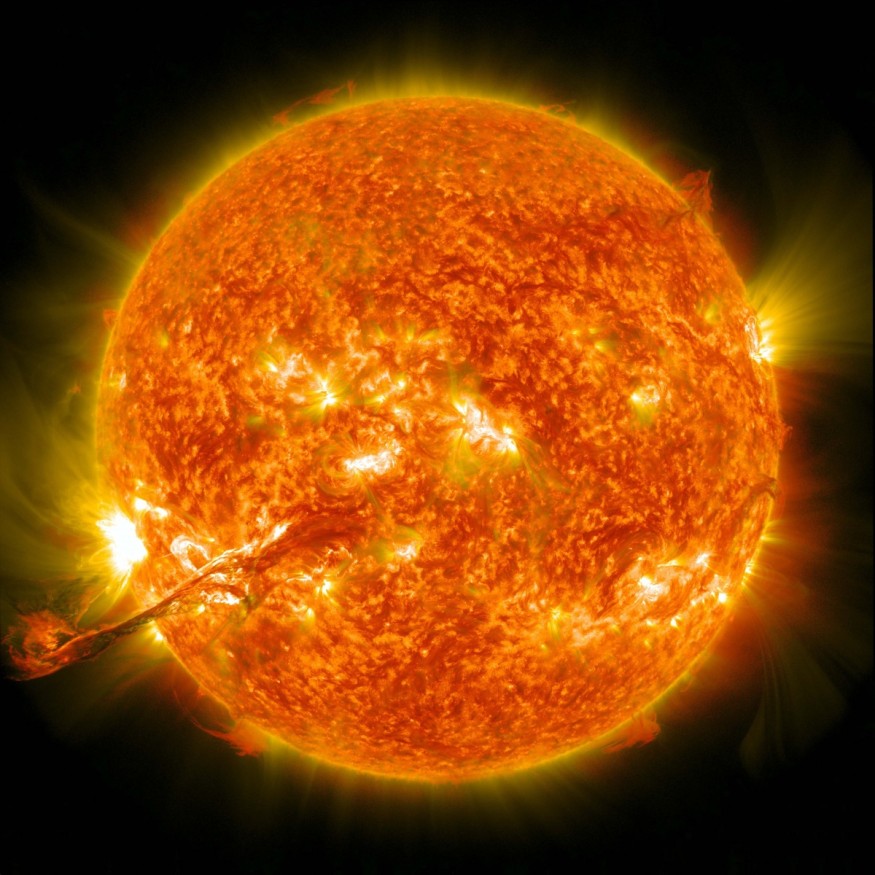NASA filmed the never-before-seen phenomenon of the moment when a piece of the Sun's northern pole broke off, which has astronomers bewildered. A video depicts an enormous filament of plasma, or electrified gas, blasting out from the Sun, splitting, and then circling in a "vast polar vortex."
Scientists believe the prominence is related to the reversal of the Sun's magnetic field, which occurs during a solar cycle. Space weather forecaster Tamitha Skov uploaded the video on Twitter with a caption saying that NASA's Solar Dynamics Observatory captured it.

Solar Filaments Broke Off From the Sun
Skov wrote in her Twitter post that the strange circular vortex coming from the Sun is a solar filament that is now circulating in a massive polar vortex around its northern part. NASA said these solar filaments are clouds of charged particles that float above the Sun attached via magnetic forces, which could last from hours to days.
Talk about Polar Vortex! Material from a northern prominence just broke away from the main filament & is now circulating in a massive polar vortex around the north pole of our Star. Implications for understanding the Sun's atmospheric dynamics above 55° here cannot be overstated! pic.twitter.com/1SKhunaXvP
— Dr. Tamitha Skov (@TamithaSkov) February 2, 2023
The recent solar filaments look like elongated, uneven strands that emerged from the Sun's surface. Skov pointed out that the prominence it showed appears precisely at the 55-degree latitude around the polar coronas every 11 years.
"Once every solar cycle, it forms at the 55-degree latitude and it starts to march up to the solar poles," said Scott McIntosh, deputy director of the National Center for Atmospheric Research in Boulder, Colorado told Space.com.
He added that the solar filament is a bit strange and raises questions, such as why it only migrates toward the pole and then disappears and reappears every three to four years in the same region.
While scientists have previously detected filaments breaking away from the sun, this is the first time a whirlwind has passed through the area. In 2015, two long strands of solar material burst into space after breaking loose from the sun.
The higher one shattered first, releasing black plasma into an active zone underneath it. That lower filament erupted an hour or two later. Scientists are still trying to figure out what caused the filament in the latest observation to whirl around the sun rather than shoot out into space.
READ ALSO: Major Solar Storm Hits Earth: Northern Lights Expected to Appear in Britain's Night Sky This Week
Sun Is Nearing Its Active Phase
The Sun's current rise in activity is due to it approaching the most active period of its 11-year solar cycle, which will peak in 2024, MailOnline reported. Astronomers are seeing stronger solar radiation, greater solar material ejection, more sunspots, and more severe solar flares.
Studies show that the present level of solar activity is around the same as it was 11 years ago, at the same stage in the last cycle. In August 2022, the European Space Agency's (ESA) Gaia probe predicted that the Sun is about halfway through its existence.
It will expand and kill Earth when it reaches the end, but data from the craft indicates that this will not happen for at least another five billion years.
Gaia calculated that the Sun is around 4.57 billion years old and projected how the solar would evolve by determining its mass and composition.
The Sun's demise began approximately 10 to 11 billion years ago when it quickly expands in size. The Sun will die as a cold, faint white dwarf, the heated, dense core of a dead star. The Sun is currently considered middle-aged and steady as it fuses hydrogen into helium.
RELATED ARTICLE: Intensified Sunspot, Solar Flare to Happening 1-3 Years from Now Could be One of the Most Active Activities of Its Kind
Check out more news and information on Sun in Science Times.
© 2026 ScienceTimes.com All rights reserved. Do not reproduce without permission. The window to the world of Science Times.












